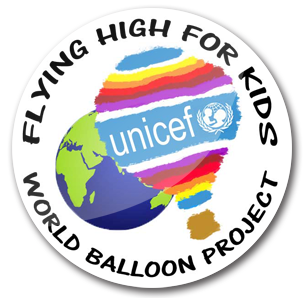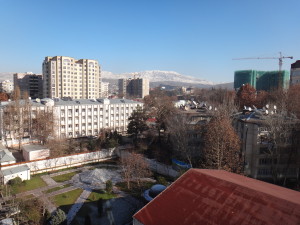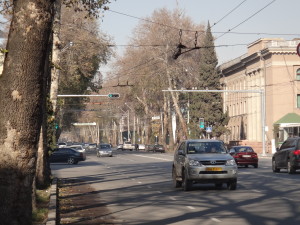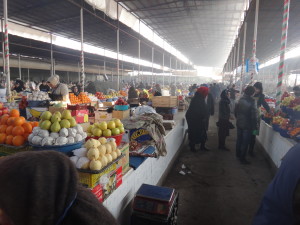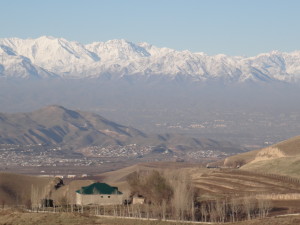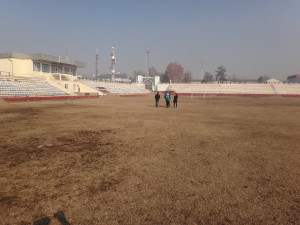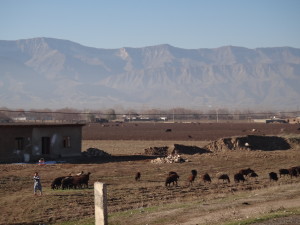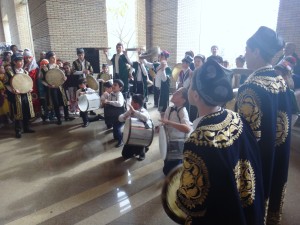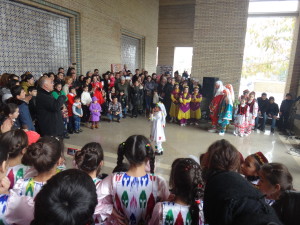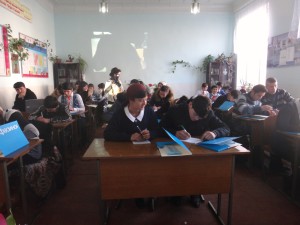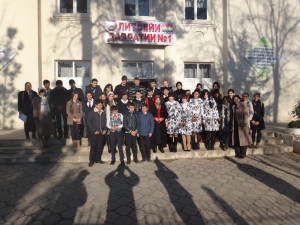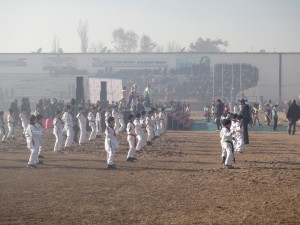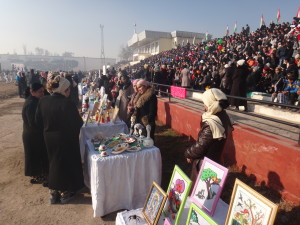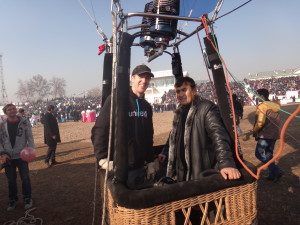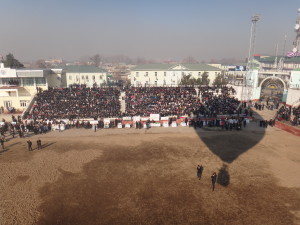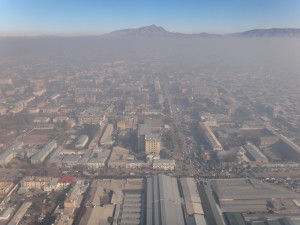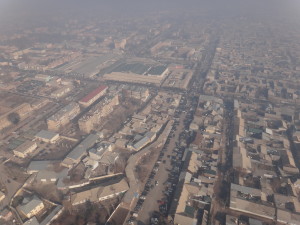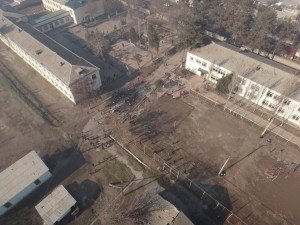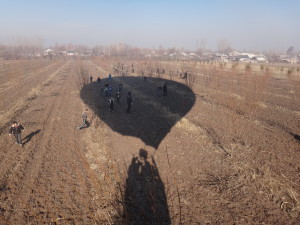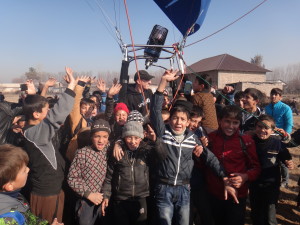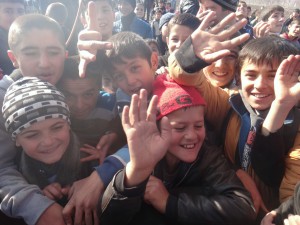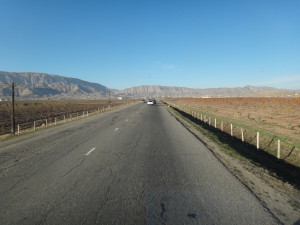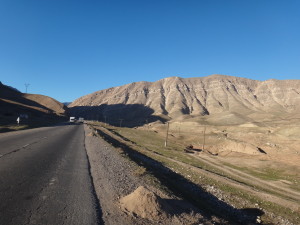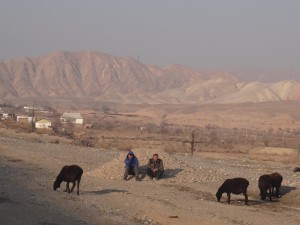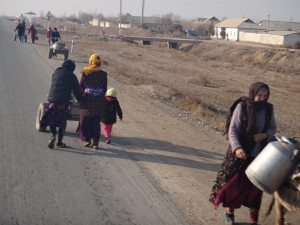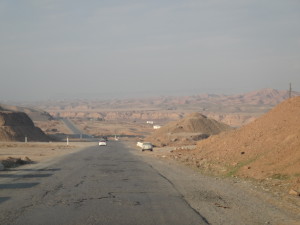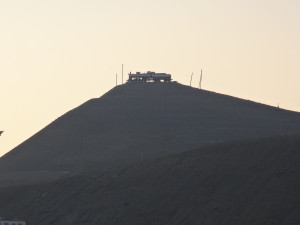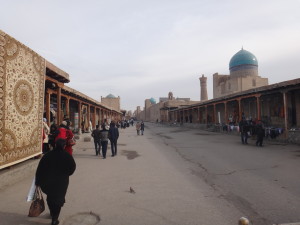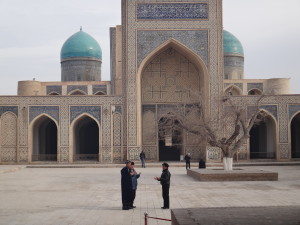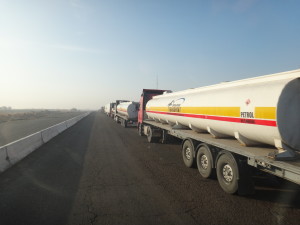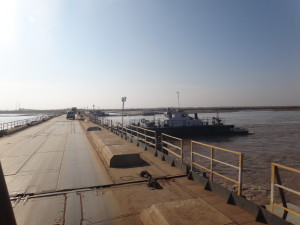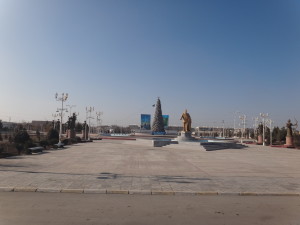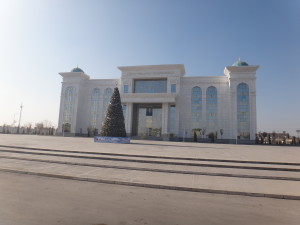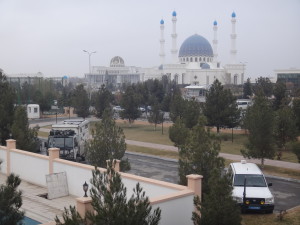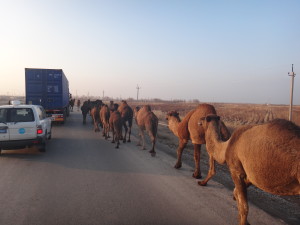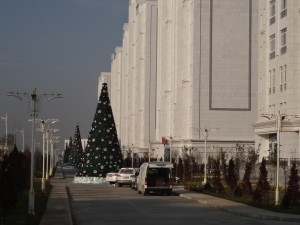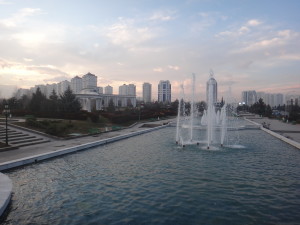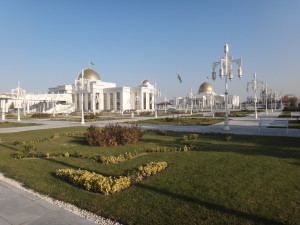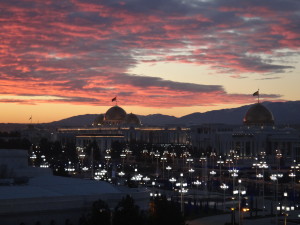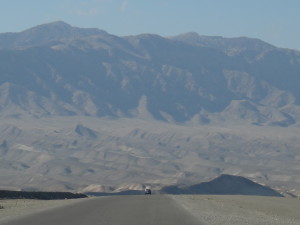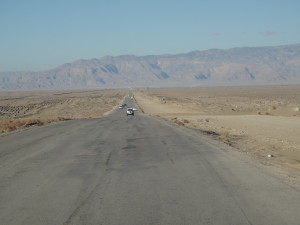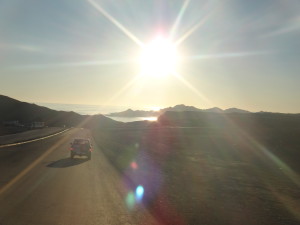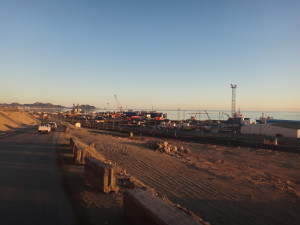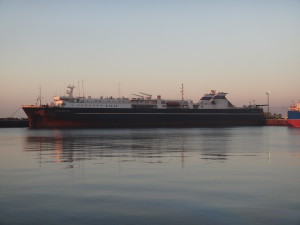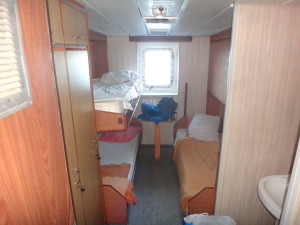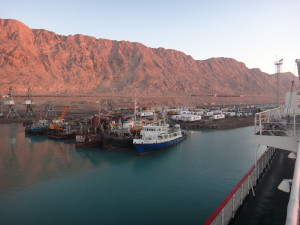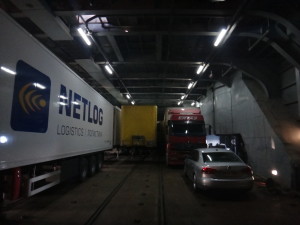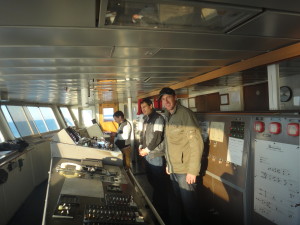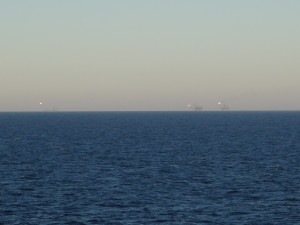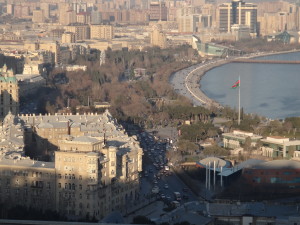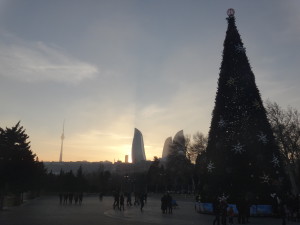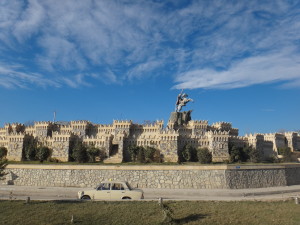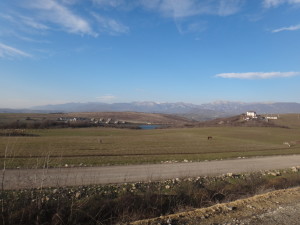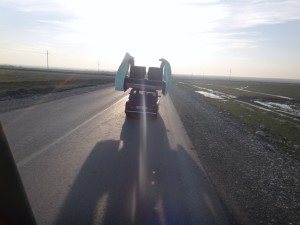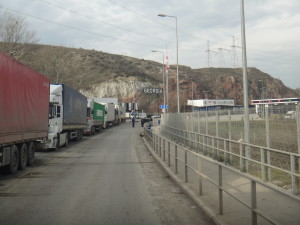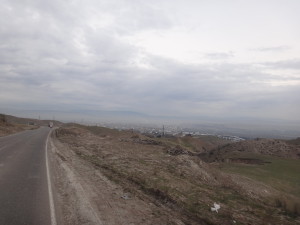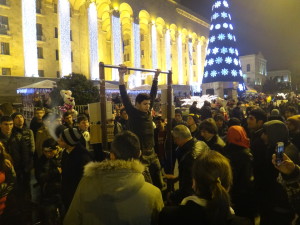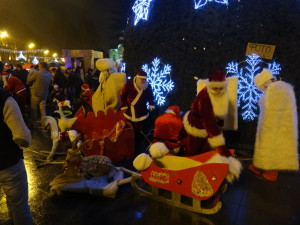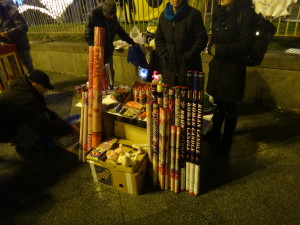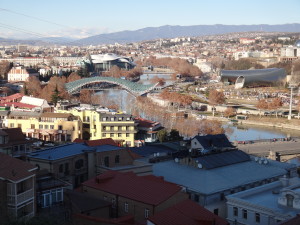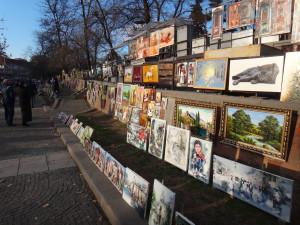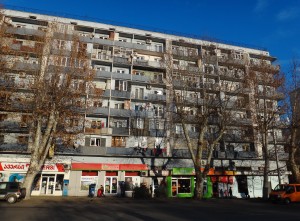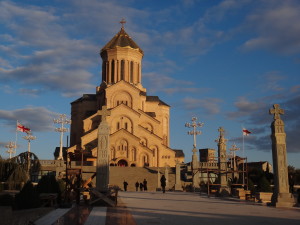Thousands Of Happy Kids
Malaysia, Part 1
December 4, 2014Georgia, Armenia, Turkey
January 24, 2015I was at the UNICEF office each day for the week after we arrived in Dushanbe, Tajikistan. We worked on the event that we planned for the city of Qurghonteppa, in the south of the country. It was nice to have a place to sit and work on plans for upcoming countries. I had a lot to catch up on.
In the same week, we applied for our Azerbaijan visas. The consul there was very friendly and he told us that they would be ready later that week.
In the weekend I took the chance to walk around Dushanbe. As with most ex-soviet cities, there are a lot of monuments and soviet-style buildings. Most buildings are low-rise due to the risk of earthquakes. The government district is very modern with impressive buildings. It also boasts the second-tallest flag pole in the world.
The main street is lined with matures trees, which were dropping a lot of leaves. An army of sweeper-women were kept very busy sweeping the leaves into piles. We had noticed that many Central Asian cities are kept very clean, especially the main cities in Uzbekistan and Tajikistan. It isn’t common to see litter or graffiti. Thousands must be employed keeping the cities clean and tidy.
I tried to change some money, from Uzbek Som to $US. Most places wouldn’t change Som. There are political problems between Uzbekistan and Tajikistan and the Som is a risky currency as it is worth so little and quite volatile. One money changer told me it was only good for toilet paper! The other problem is that everyone wants to hold onto their $US due to the economic problems in Russia. The Tajik Somoni was losing its value as it relies heavily on the Russian economy. 53% of Tajikistan’s GDP comes from Tajik workers in Russia sending money home. If the Russian economy is doing badly, Tajikistan’s is too. Same goes for Kyrgyzstan, and Uzbekistan to a lesser extent.
We drove 100kms to Qurghonteppa the next day to check out the take off site and the general flying area for the event the next week. The City is the 3rd largest in Tajikistan and was the epicentre of the civil war, which lasted for 6 years from 1993. The road there is quite good, though there are some rough, badly sealed parts. We arrived one hour early before our planned meeting with the Deputy Mayor. We decided to look around the bustling market to fill in time. It covers quite a large area and everything can be bought there. Many people wore traditional clothes.
When it was time, we went to meet the Deputy Mayor at the city’s municipality building. She had asked a number of school principals to be there, so we were surprised to see quite a number of other people in the room with us. They were going to be briefed by her about what was going to happen at the event. She was very enthusiastic about having us and was doing all she could to support us. She had even arranged for 5000 children to attend the event, hence why so many school principals were present.
We went to look at the launch site after the meeting, the local stadium, which seated around 8000 people. All looked good, so we headed back to Dushanbe quite happy with how things were shaping up.
I was invited to speak at an event being put on as part of the International Day of Persons with Disabilities a couple of days later. It was a craft fair with children’s performances and being put on by a number of organisations, including UNICEF. There were some very nice local crafts which had been made in rural Tajikistan.
I was the first speaker of the main event and I talked about my project and encouraged children to follow their dreams. After my speech, there were some excellent dance and music performances by children of all ages.
After the event, I went with UNICEF Tajikistan’s Representative and a few others from UNICEF and other organisations to a lunch put on by a number of embassies. Each embassy prepared local dishes from their country, which people could sample. It was a great idea and everyone enjoyed themselves. I have never seen so many diplomatic cars in the carpark as I was leaving.
We drove to Qurghonteppa the next day and went directly to one of the local schools. There were five of us, three UNICEF staff, Des and I. I was surprised that they had arranged an official welcome for us. We were given flowers and a few of the school children showed us some of their work. We then went on to a classroom where around 40 kids were waiting. There was quite an age range, between 10 and 17 years old. They spoke good English and had prepared a speech about the history of UNICEF. I spoke to them about the project, New Zealand and my story about how I got into ballooning. I asked them about what they wanted to do when they left school. Doctors, military personnel and IT workers were amongst some of the answers. They were very bright students. We shared postcards and took a group photo together. It was great to have the opportunity to go into a local school and to meet the kids. The principal was also happy to have us there and said she was honoured that her school was chosen to host us.
After our goodbyes, we went to our hotel, (which was right next door to the school). There was a power cut. I was surprised to hear that for the past 20 years, there is only electricity for a few hours in the morning and a few in the evening in the winter. There is a major electricity shortage in Tajikistan. They can’t rely on their neighbouring countries for energy due to trade restrictions with Uzbekistan and Kyrgyzstan. Tajikistan is a landlocked and mountainous country with not many natural resources. This puts them in a vulnerable position. Electricity is available 24hrs a day to critical services, including hotels and government buildings. Dushanbe has electricity 24hrs a day also.
The stadium was just across the road from the hotel and we went there at around 10am the next morning. The police had closed off the streets to allow the many kids to cross the road safely. They were coming from all directions. There were around 5000 children coming after all! Luckily many schools were located close to the stadium and the kids could walk there. The day was perfect, no wind and a relatively warm 10deg. I drove the truck into the middle of the stadium and we waited for everyone to arrive. At around 11am, we were officially welcomed and given the go ahead to start. A UNICEF representative and various government officials gave speeches. Children gave performances, including dancing, taekwando, painting and musical. It was all about letting kids’ talents shine.
I inflated the balloon and kept it on the ground for a while before lifting off. The noise from all the kids’ cheers when we took off was incredible. I slowly drifted out of the stadium and towards the middle of the city. Everyone was waving and amazed by the sight of the balloon. It was the first time a balloon has officially flown in Tajikistan.
My passenger was an air traffic controller and he talked to the airport. He said I could go up to 4500m if I wanted. That was a bit much and I went to 700m. We could see Afghanistan only 60kms to the south and Uzbekistan, 60kms to the west. The mountains looked stunning above the haze.
I flew low over a school. All the kids came out and waved. They wanted us to land there, but there was no place to put the balloon unfortunately. I kept flying and kids came out and started following us as we flew. It was quite a site to see dozens and dozens of kids running down the streets following us.
We eventually landed in a new housing subdivision. A few hundred kids welcomed us. The ground crew weren’t too far behind and we deflated the balloon. The kids were super excited and not easy to control. They helped to deflate the balloon very quickly. We spent some time with the kids answering their questions and posing for photos before heading back to the city to have lunch.
As it turned out, where I had landed was the very village where the Tajik Civil War started. It was hard to think that all the houses there had been burnt down and it was a place of so much sadness for a long period of time.
After lunch, we headed back to Dushanbe feeling very content.
We found out that our permission to enter Turkmenistan had been approved. I was beginning to worry as UNICEF there had applied for it more than two months earlier and we were due to enter six days later. It was quite a relief as we would have to take quite a detour if we weren’t given approval.
Des and I went to the Turkmen Consulate the next day. It was close to the Azerbaijan Consulate, where we had picked up their visa a few days before. The consul was very friendly and said he would issue the visas that morning as we all ready had the letter of invitation. We had to go to a bank across the city to pay for the visas, then travel back to the Consulate to pick up our passports with the new visa. It was great to get it as we were leaving the next day. Getting a visa on the border is possible, but takes time.
I had a media interview that afternoon and said my goodbyes to the UNICEF staff who had worked so hard on arranging the event.
Early the next morning, we departed for the border, only 60kms away. The process of leaving Tajikistan was very simple and we were through in 20mins. Luckily we were able to find a space to sneak past the waiting line of trucks.
The Uzbek side took a bit longer. As tourists, we were given priority. The government has given an order to the police to try to be as welcoming as they can to tourists. We got through in about 2hrs. The border was very busy compared to when we were there two weeks earlier with only two other Russian cars. This time the border was full of TIR trucks.
Our goal for the day was to get to Bukhara in the west of Uzbekistan, around 500kms from Dushanbe. We took a slightly different route on a slightly longer road, which we had hoped would be better. The road was similar to the route we had all ready travelled, ranging from perfect to terrible. A lot of the main roads are under construction and it is possible driving will be a breeze in Central Asia in a few years time.
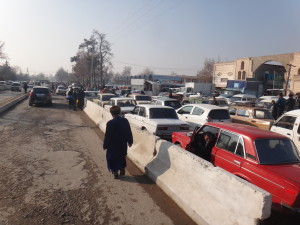
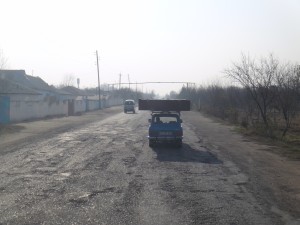
I really enjoyed Southern Uzbekistan. It is very wild and a bit desert-like as you head further south, nearer Afghanistan. People still live in quite a traditional way and are friendly and authentic. The hills and mountains are beautiful to drive through.
We had to stop to register three times along the main road north. All people travelling along the road have to register their name, passport number, type of vehicle, etc with the police. There is a lot of drug trafficking and I assume it is a security measure for that. Afghanistan is not far away either.
We made it to Bukhara at night and found a hotel. All foreigners must register and stay at hotels while staying in Uzbekistan. The hotel had a big gated courtyard, so the truck was very secure. Central Asia feels very safe. The crime rate is low thanks to a large police presence.
It was an enjoyable following day looking around the old Silk Road city of Bukhara. I think it is better than Samarkand as it has more of a feel of an old city. It was great to explore the old mosques, mausoleums, forts and markets. There weren’t many tourists around, so we could see how traditional day to day life was. I can imagine it is packed with Tourists in the warmer months.
At 8am the next morning we left for the Uzbekistan/Turkmenistan border, around 100kms away. There was a thick fog in places which I had to slow down for. We still made it to the border in good time and passed the 3km long line of truck waiting to cross into Turkmenistan. Going through the Uzbek border was a breeze. With some moving of trucks, we managed to get down the narrow road to the Turkmen border in no-man’s land. There were trucks everywhere. It is at least a 1km drive to the Turkmen border.
We got our passports stamped and I went to do the paperwork for the truck. I asked one of the officials to call the UNICEF staff member who was meeting us there. As part of entering Turkmenistan, we had to have someone from UNICEF with us while driving. The staff member, Yasha, arrived a few minutes later and helped us with the paperwork. We were able to get into Turkmenistan without paying road taxes as we were there on a Service Visa. This meant we saved a few hundred dollars. The tax is there to stop people from buying lots of fuel and taking it out of the country by vehicle. Fuel is very cheap, diesel costs around US20c a litre. In Turkmenistan, gas to homes is free and everyone gets a quota of electricity for free also. Turkmenistan sit on huge oil and gas reserves and the government shares this wealth.
We were through the border in around 90minutes. Things were less complicated because of being associated with UNICEF.
We travelled across a long floating bridge before entering Turkmenabat. It is impressive, not only for its length, but because two tug boats are pushing in the middle of the bridge to keep it in place. A new bridge is being constructed, but is still quite a way from being completed.
We stopped in Turkmenabat to eat before continuing to the city of Mary. The road was quite good and will also be upgraded with a four land highway in years to come. We arrived into Mary in the late afternoon and met with another UNICEF worker, Gulyalek, who had been working on the necessary permissions to inflate the balloon and get us into the country. We all went out for dinner together that night and were informed that they were still waiting for the final permission to be granted.
We waited in the hotel the next day and hoped that the permission would come through so we could inflate the balloon at a school in Mary. It didn’t come, so we pushed on to Ashgabat and arrived late in the evening.
We hoped again that the permission would be granted for an inflation there, but it was not to be. The permission has to come from various agencies and we had run out of time unfortunately. I hope to come back later this year and give it another go. Once this was confirmed, we decided to have a look around the impressive city of Ashgabat.
It is a city that has been almost completely re-built over the past 10 years. White marble tiled buildings cover the sky line. Turkmenistan will host the Asian Games in 2017 and everything is looking in great shape. People are being re-housed into new apartments, so the old part of the city is slowly disappearing. The whole place looks new with wide streets, impressive monuments and water features. There is an army of cleaners making sure everything is looking at its best. It was funny to walk around a big part of the city and seem to be the only one walking on the street, except for the many cleaners and police keeping things in order.
You can’t help but marvel at the amount of money that must have been spent on infrastructure, even the bus shelters are comfortable buildings complete with a TV inside.
We spent Christmas in Ashgabat and were invited on Christmas Eve to have a traditional meal with Gulyalek and another one of her co-workers that had been working on attaining the permissions. We were treated to a delicious meal of local food and were very full by the end. It was a kind gesture considering that Turkmenistan generally doesn’t celebrate Christmas, the general population are Muslim. You see Christmas trees everywhere, but they relate them to the New Year, rather than Christmas. Christmas trees were a Russian tradition that stayed from the Soviet time.
We left Ashgabat with a UNICEF driver and drove the 570kms to the port city of Turkmenbashi. The countryside is desert-like and it was relatively common to see herds of camels. You can’t get very lost in Turkmenistan as there are not many main roads, the most used one is the one we took, from Turkmenabat to Turkmenbashi. We crossed a large dry lake bed and passed a number of towns along the way. It was an enjoyable and relatively easy drive.
We arrived into Turkmenbashi just before sunset. We headed straight for the port to find out if there were any ships travelling to Baku. The crossing to Baku is infamous as there is no set timetable. The ships go when they are full. We were in luck and there were two leaving that night. We went into the city to eat quickly before returning to the port.
We weren’t able to get onto the first ship, but the second was no problem. The UNICEF driver told us what needed to be done and he departed at around 9pm. We had to wait until the second ship came into port and was offloading before we could start the paperwork. They said it would be 1.5hrs, but I got the feeling it would be much longer. I went to the truck to get some sleep and Des slept in the waiting area in case something happened.
I got up at 1am to see if anything had happened. Nothing had, so I waited around in the passenger hall. We were eventually called at 4am to do the paperwork. I went from office to office filling out paperwork. It would’ve been much faster, but I was going against the tide of Turkish truck drivers who had just gotten off the ship. Luckily I can speak a bit of Turkish and they helped to point me in the right direction. I also managed to change some money with one of them. Being a truck driver in Central Asia is an unenviable job. They are constantly waiting in long lines at borders. They told me to drive from Turkey to Uzbekistan can sometimes take up to a month! The wait on the Iranian border can be 10 days alone, so many decide to go across the Caspian Sea to avoid it.
We boarded the ship at 6.30am and found there was only one other passenger with us, a Turkish truck driver. Three more passengers boarded later, but we never saw them again until we got off in Baku. The ship was full of empty trailers returning to Turkey.
About an hour after boarding, we were shown our compartment. It was basic, four bunk beds and a basin. I had a nap and awoke at 10.20am to the sound of the ship’s engines starting.
I went to the top deck to have a look. Des was also there watching. I spoke to one of the crew and asked him about the ship. It was a Soviet boat that used to run between Azerbaijan and Kazakhstan. It was built in Yugoslavia in 1986, could take 34 railway carriages, (or the equivalent in vehicles) and 200 passengers in compartments. It had definitely seen better days, but everything still worked.
We had free reign of the ship and were even allowed to go up to the bridge. The captain showed me the charts and where all the oil and gas rigs were. There are many in the Caspian Sea. The weather was perfect, though the wind was a bit chilly and it was an enjoyable trip across. We had Lunch and dinner in the cafeteria, basic food such as chicken and fries was served.
I got some rest again at around 8am as I thought it might be another long night of border clearances.
We arrived at around midnight and I heard the anchor drop. I looked out the window and could see the lights of Baku in the distance. I assumed that there wasn’t a place in the port for us, so went back to sleep. I was right, I was awoken again by the sound of the ship’s engine at 5am and we were on the move. A ship attendant told us to get out of bed as we would be docking soon. We got up, gathered our things and went down to the truck.
We watched as they opened the cargo door and reversed the ship into port. Once docked, we were asked to go back upstairs for Immigration clearance. Two officers boarded the boat and stamped our passports into Azerbaijan.
We drove off the ship at around 6.30am, (we had gone back one hour in time) and went to the Customs office. They were friendly and processed my paperwork.
We had to wait until 9am for the payment office to open. The ship is from Azerbaijan, so payment of cargo for the crossing is made before you leave port.
The office opened a bit late, and after some to-ing and fro-ing with paperwork, we were allowed out. The payment official made a mistake and had to re-print some of my paperwork that he had just written up. He tore up the old one, but accidentally tore up my Customs Paperwork along with it. He spent a bit of time gluing everything back together, so I was there a bit longer than I should’ve been.
I decided with UNICEF Azerbaijan not to have an event there due to the holiday season and everything being closed, so Azerbaijan was just a transit country for us.
We stayed in a hotel that night. Baku is a very impressive city and such a contrast with the other cities across Central Asia we had been to over the past few months. It was a very busy place, with lots of international brands and obviously a lot of investment from oil and gas income. It is also quite expensive, one Azerbaijan Manat is equal to about one Euro.
Everything was looking in top shape as Baku will be holding the 1st European Games later this year. I was impressed with the architecture of some of the buildings and the mix of old and new. It was a very full afternoon with many kilometres covered walking around the city.
We had only a 3 day transit visa, so we had to leave Baku the next morning. We decided to take the back road through the mountains to go north. It is shorter, but much more windy.
The road was good until we got towards the top of the tallest mountain, where an elite holiday village was located. After that it became narrow and windy. The view was spectacular on the other side and you could look out to the mountains on one side and a vast plain on the other. The road suffers from a lot of slips and I can see why not many people use it.
We got back onto the main road, another being upgraded, and the going was slow. It eventually got better and we stayed at a very nice truckstop just outside the city of Ganja. Just before we got there, we were stopped by the police in a patrol car. I have no idea what they were stopping me for because I hadn’t done anything wrong, but they wanted 50 Manat from me to make them go away. They couldn’t speak English, so I just started ranting in English. They eventually got bored and left.
We drove the last 150kms to the Azerbaijan/Georgian border. I filled up with fuel as I was sure it would be the last country where we could get relatively cheap fuel, (Around US$1/litre for diesel). The Azerbaijan/Georgian border was the easiest border crossing so far. The Azerbaijan side sent a drug sniffer dog through the truck as they said we had come through a lot of countries which are known for drug trafficking. It only took a few minutes, but dirty paw prints were left through the truck.
The Georgian border entry was very simple. All the details were entered onto a computer, so no paperwork was needed to be filled out.
To get through both sides only took 40mins.
It was a short drive to Tbilisi from there. We found a place for lunch and bought a sim card. We paid a visit to the Armenian Consulate to apply for our last visa. They said that they had just closed for the holiday and wouldn’t re-open until the 12th of January! I had heard that a visa could be applied for at the border. Luckily this was true, otherwise we would’ve had a problem.
We had a walk around Tbilisi that afternoon and parked up on a street in the central city for the night.
I have a balloonist friend in Tbilisi who was arranging the flight permission for our event there. We paid him a visit the next morning and went to find a suitable launch site in a small town just outside of Tbilisi for the event. The person organising the event on behalf of UNICEF Georgia was also there.
We decided to stay in a hotel as Des was feeling under the weather. We found a cheap one on the other side of the city. It has been a good base for the past few days. I went into the city to see in the New Year. It is possible for the average person to buy large fireworks here, which I’m sure would be banned in many countries. I found a great place with a view of the city, and just before midnight, the whole city was lit up with thousands of fireworks. It was really impressive and a spectacular site.
The first couple of days of the New Year were quiet due to poor weather, but I got out yesterday and had a good look around. There is something for everyone in Tbilisi. It is well cultured. There are many old stone and wooden buildings in the old city, including many churches. The Georgian Orthodox church is very strong here, with many devout followers. Many people still do the sign of the cross as they walk past a church.
I climbed a hill and got a great view of the city. The Mtkvari River flows through the centre and mountains surround it. The city has a vibrant feel to it. The population is around 1.5 million.
Tomorrow I will either fly or tether the balloon in the old town of Mtskheta. It will depend on the wind speed and direction. A number of kids will be there. I will talk to them about the balloon and give them gifts for New Year.
The following day I have a 20 minute live interview on a popular Georgian TV show.
We leave for Armenia on the 7th, where another event is being planned for the middle of the month in the Capital, Yerevan. It will be our last event for this leg of the project before having a six week planning break in Turkey to get ready for the European leg.
You can track our movements thanks to one of our supporters, the shipping and logistics company, DB Schenker. Go to:
www.dbs-smartbox.com/main.pl
Both the username and password are ‘unicef’.
